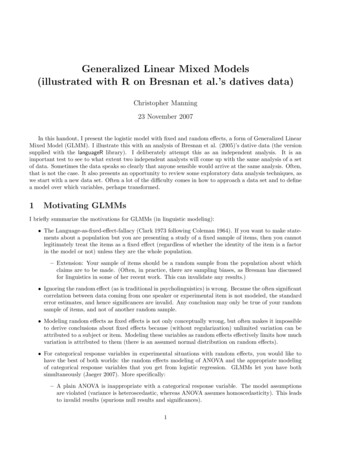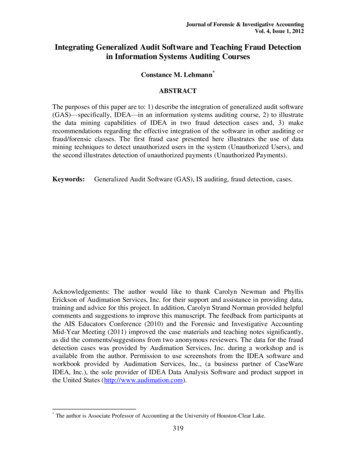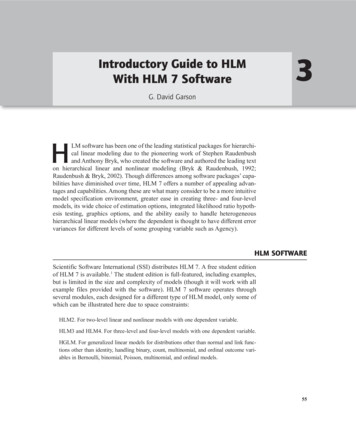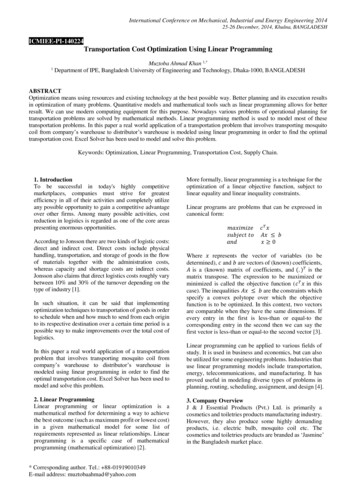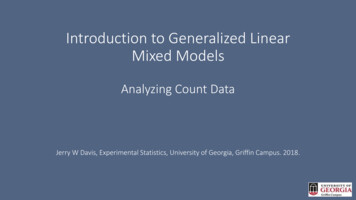
Transcription
Introduction to Generalized LinearMixed ModelsAnalyzing Count DataJerry W Davis, Experimental Statistics, University of Georgia, Griffin Campus. 2018.
Traditional Analysis of VarianceAnalysis of Variance rests on three basic assumptions Response variables are normally distributed Individual observations are independent Variances between experimental units are homogeneousSmall deviations from these assumptions are not critical Analysis of Variance methods are very robust Central Limit Theorem says that data with many observations have normallydistributed means
Analyzing non-normal dataOld techniques: Assumptions were / are often ignored Transformations were used to “normalize” the dataImprovements: Advances in statistical techniques allow categorical data to be modeledlike normal data Computer hardware and software can solve numerically intensiveproblems Analysis of variance models incorporate different distributions sonormality assumptions are unnecessary
Analysis of Variance Models Linear Models (LM), normal (Gaussian) data, PROCs GLM, REG, ANOVA Linear Mixed Models (LMM), normal (Gaussian) data, random and / orrepeated effects, PROC MIXED Generalized Linear Models (GLM), non-normal data, PROCs LOGISTIC,GENMOD Generalized Linear Mixed Models (GLMM), normal or non-normaldata, random and / or repeated effects, PROC GLIMMIX GLMM is the general model with LM, LMM and GLM being specialcases of the general model
Generalized Models The term generalized refers to extending linear model theory toinclude categorical response data. Non-normal data can be analyzed in a conventional analysis ofvariance framework F and t tests Mean separation tests
Generalized Linear Mixed Models Selecting the correct distribution for categorical response variables isvery important Follow the guidelines presented here and in the references Error messages provide little or no guidance in matching a responsevariable to a distribution Never seen: Hey, your distribution does not match your response variable
Counts: Poisson or Negative Binomial distribution Non-negative integers, often right skewed Number of insects, weeds, or diseased plants, etc., within anexperimental unit Counts are unbounded. Biological limits (cotton bolls / plant) are not bounded – OK The number of plants that died out of ten is bounded – not OK
Binomial: Binomial distribution Discrete positive integers between 0 and n The number of successes from n independent trials When n equals 1, it is a Bernoulli trial (coin toss) Usual outcomes are 1 or 0, alive or dead, success or failure Also called discrete proportions - events per the number of trials Eggs hatched from the total number of eggs Seeds germinated from the total number of seeds planted Plants that survived drought from the total number of plants
Continuous proportion: Beta distribution Proportion of affected area within an experimental unit Expressed as a percent (decimal fraction, i.e., 0.12, 0.25, etc.) Area of a plot with disease or insect damage Damaged leaf area Lesion size per total area
Ratings and ranks: Multinomial distribution Subjective measurement based on a discrete scale or criteria Disease ratings, sensory evaluations, herbicide efficacy rating Response variables need not be numeric. Good, fair or poor are asvalid as 1, 2 or 3. Linear scale implies the difference between ratings is equal Non-linear scale implies the differences are not equal The difference between ratings 1 and 2 on a six point scale is not equal to thedifference between ratings 5 and 6
Poisson distribution Mean is equal to the variance (µ σ2) Implies that counts are uniformly distributed Agriculture counts tend to be clustered - over-dispersed Over-dispersion – variance is larger than the mean May cause inflated F values and underestimate standard errors Under-dispersion – variance is smaller than the mean Less problematic
Negative Binomial distribution Similar to the Poisson distribution Includes a scale parameter (δ) so the mean and variance need not beequal (µ σ2) May be more appropriate for agricultural counts
Pseudo – likelihoods Residual Pseudo-likelihood (RSPL) Default estimation method for GLIMMIX and non-normal data Does not produce a true log-likelihoodConsequences: Model is not conditioned by the random effects Only a conditional model can diagnose over-dispersion Fit statistics (AIC, BIC, AICC, etc.) cannot be calculated
Pseudo – likelihoodsSolution: Change estimation method to adaptive quadrature or Laplace Both methods fit a true log likelihood function Add method laplace or method quad to the PROC GLIMMIXstatement Try one method and if there are problems switch to the other
Adaptive quadrature Adaptive quadrature is said to be more accurate than LaplaceSide effects: ddfm options kr2 and satterthwaite are not available Omit the ddfm option so GLIMMIX will default to containment Random effects must be processed by subjects random intercept / subject block; random block; does not work Continued
Adaptive quadrature When there are two random effects, such as block and year, writingtwo separate random statements is flagged as an error.For example: random intercept / subject block; random intercept / subject year;Solution: use one statement with the interaction term random intercept / subject block*year;
Laplace Laplace is less restrictive than adaptive quadrature ddfm kr2 or satterthwaite is not available for Laplace Omit the ddfm option so GLIMMIX will default to containment Random effects need not be processed by subjects, but it is a goodidea to do so Multiple random statements are allowed random intercept / subject block; random intercept / subject year; The Laplace option may be a better first choice than quadrature Less restrictive and often works better
Repeated Measures PROC GLIMMIX uses a random statement and the residual option tomodel repeated (R-side) effects. Adaptive quadrature and Laplace cannot model R-side effects Repeated effects must be modeled using random (G-side) effects Method is similar to doing a “split-plot in time” The difference is subtle and illustrated with an example
Link functions Response data remains on the original data scale when a model is fit LS-means are on the model scale when they are estimated The link function links the model scale means back to the data scale This is not the same as transforming the data, fitting a normal theorymodel and then back transforming the means Each distribution has a default link function
Distributions and Link functionsDistributionLink FunctionSyntax dist Syntax Link BetaLogitdist betalink logitBinomialLogitdist binomial bin blink logitNormalIdentitylink identity idMultinomialCumulativelogitLogdist gaussian g normal ndist multinomial multi multdist negbinomial negbin nbdist poisson poiNegativebinomialPoissonLoglink cumlogit clogitlink loglink log
Concepts for fitting a GLMM An analysis of variance model is a vector of linear predictors (equation)with unknown parameter estimates Every distribution has a corresponding likelihood function The vector of linear predictors is substituted into the likelihoodfunction Parameters are estimated by minimizing the –log likelihood function LS-means are derived from the parameter estimates and are on themodel scale The link function converts the model scale LS-mean estimates back tothe original data scale
Key concepts PROC GLIMMIX uses a distribution to estimate model parameters PROC GLIMMIX does not fit the data to a distribution Response data values are not transformed by the link function The link function converts the LS-mean estimates back to the datascale after being estimated on the model scale
CountSeminar1.sas
Results – Negative Binomial Values for Pearson Chi-squared / DF and AICC are better than Poisson Accounted for over-dispersion Unbiased F-values and standard error estimates More intuitive LS-mean separation tests It may be better to start with a negative binomial distribution I like to start with Poisson because it tells me if the data are over-dispersed,and may indicate or highlight other problems.
Results – Negative Binomial What if over-dispersion or other problems remain when using anegative binomial? Examine the data for sparse or constant values. Sparse data may need to be summed over treatment levels, locations or time Some data may need to be sacrificed for a better analysis If all else fails, select the model with better diagnostics andinterpretable results
Describing the analysisThe response data were analyzed with an analysis of variance modelusing a negative binomial distribution in PROC GLIMMIX (SAS/STAT,2017).Or something similar
Repeated Measures analysis R-side model for normal data random day / residual subject rep*treatment type cs; ERROR: R-side random effects are not supported for METHOD LAPLACE. G-side model for non-normal data method quad or method laplace random day / subject rep*treatment type cs; Remove the residual keyword and the repeated effect is modeled much like“split-plot in time” See Appendix B for the full program
CountRepeatedSeminar1.sas
Repeated Measures analysis Other ways to handle repeated measurements Analyze within the time or space variable Sum across time or space Summing has the potential advantage of handling sparse data
Common problems The zero covariance estimate for rep Causes this message
PoissonBadMeans.sas
Detecting problems Check the output tables to ensure that results are consistent Examine model diagnostic tables and the ANOVA table before the LSmean tests If some of the results look fishy, something is probably wrong Never blindly accept computer output!
Detecting problems Sparse data is the most common problem I see when analyzing countdata If nothing else can be done, delete treatment levels with zero or nearzero counts LS-means are always tested to see if they are different from zero If a treatment level has all zero values, it is a constant Therefore the initial test should be sufficient for a difference between the two Again, summing over time, space or treatment levels may beacceptable options when analyzing problem data Analyses within factors may also be an option
Detecting problems The problematic LS-mean tests can occur with GLM, MIXED andGLIMMIX Not limited to treatment levels with all zeros Other data problems may be the culprit Hard to diagnose problems from large multi-factor experiments withmessy data Keep this in mind when designing the experiment
Convergence Mixed model procedures use iterative algorithms to minimize the–log likelihood function The algorithm (method) may encounter a problem and stop The process failed to converge and did not find a solution Non-convergence is like a lack-of-fit test – it implies that thedata does not support the model
Convergence SAS messages indicating not-convergence Note: An infinite likelihood is assumed in iteration 0 because of a non-positivedefinite R matrix for ‘variable name’ ‘place’ Note: Did not converge. Error: Insufficient resources to determine number of quadrature pointsadaptively. The last successful .
Convergence: causes and possible remedies Repeated measures – one observation per subject per time point Possible data entry problem Response variable are large (10,000 – 1,000,000 range) Divide values by a constant – will not affect significant tests Over parameterized model Reduce the number of random effects Miss-specified model Check the factors in the class, model, random and repeated statements
Convergence: causes and possible remedies Too many subjects Combine subjects into groups, i.e., group individual cows into pens or lots Data problems check data values carefully Change the maximum likelihood estimation method (method ) Maximum number of iterations reached Increasing the number of iterations rarely works. Look for other problems.
Convergence: causes and possible remedies Sometimes simple remedies will not lead to convergence Redefine the problem or scope of the experimentSacrifice some data to salvage tests for other factorsDo not get too creative with data manipulationsBe prepared to explain data or factor manipulations There is always PROC GLM
Questions, Comments or Suggestions?Jerry Davisjwd@uga.edu770 228-7237
Binomial: Binomial distribution Discrete positive integers between 0 and n The number of successes from nindependent trials When nequals 1, it is a Bernoulli trial (coin toss) Usual outcomes are 1 or 0, alive or dead, success or failure
